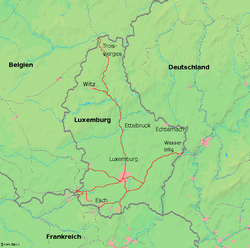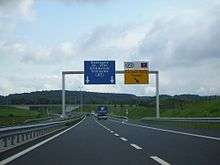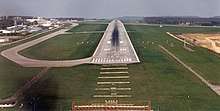Transport in Luxembourg
Transport in Luxembourg is ensured principally by road, rail and air. There are also services along the River Moselle which forms the border with Germany. The road network has been significantly modernised in recent years with motorways to adjacent countries. The advent of the high-speed TGV link to Paris has led to renovation of the city's railway station while a new passenger terminal at Luxembourg Airport has recently been opened. Trams in the capital were introduced in December 2017 and there are plans for light-rail lines in adjacent areas.
All public transport in Luxembourg (buses, trams, and trains) has been free to use since 29 February 2020.[1][2][3][4][5]

Railways
Operated by Chemins de Fer Luxembourgeois (CFL), Luxembourg's railways form the backbone of the country's public transport network, linking the most important towns. The total length of operational (standard gauge) track is 274 km, though it was some 550 km at the end of the Second World War. There are regular services from Luxembourg City to Ettelbruck, Esch-sur-Alzette, Wasserbillig and Kleinbettingen while international routes extend to Trier, Koblenz, Brussels, Liège, Metz and Nancy.[7]
The railway network links into Belgium, Germany and France. Some of the cross-border services are run by CFL, others by SNCF, NMBS/SNCB and DB.
There is now a frequent high-speed connection to Paris via the LGV Est line. EuroCap-Rail is a proposed high-speed axis connecting Brussels, Luxembourg (city), and Strasbourg.
Roads
Road network

The six Luxembourg motorways cover a total distance of 152 km, linking the capital with Trier (Germany), Thionville (France) and Arlon (Belgium) as well as with Esch-sur-Alzette and Ettelbruck in Luxembourg. Luxembourg's motorways are toll free. The speed limit is normally 130 km/h, 110 km/h in rainy weather. With 56.8 km of motorway per 1,000 km2, Luxembourg probably now has the highest density of motorways in Europe.[8]
Luxembourg City is a major business and financial center. Many workers prefer to live in the three neighboring countries and drive to work each day. This creates huge traffic jams during peak commuting hours. Tailbacks on the E411 motorway can extend five or more kilometers into Belgium and can take an hour or more to navigate.
The remaining road network in Luxembourg accounts for a total length of 2,820 km, consisting of 798 km of trunk roads (RN or routes nationales) and 2,022 km of secondary roads (CR or chemins repris).[9]
Bus services
Comprehensive bus services linking the towns and villages of the Grand Duchy of Luxembourg are contracted out to private operators by the RGTR (Régime général des transports routiers) under the Ministry of Transport.[10]
Luxembourg City is served by 163 of its own AVL (Autobus de la Ville de Luxembourg) buses transporting some 28 million passengers per year (2007). As with the RGTR, AVL contracts out to private operators for a number of services. Most of these buses are in AVL colors but the owner's name is often mentioned on them in small print. Also, the letters on the license plate can give ownership away to those that know how that system works. There are 25 regular bus routes plus special bus services through the night.[11]
The TICE or Syndicat des Tramways Intercommunaux dans le Canton d’Esch/Alzette operates several bus routes. They are centered on the city of Esch-sur-Alzette in the southeast of the country. Most are urban and suburban routes but some extend into the surrounding countryside.[12]
CFL, the Luxembourg railway company, operates some 17 bus routes, mainly serving towns and villages that are no longer served by rail.[13]
A number of smaller cities like Ettelbruck and Wiltz have started their own local services, some of which reach out to nearby villages. These services are not part of the RGTR and national tickets are not always honored.
All transport companies work together under the Verkéiersverbond, which covers all bus, tram, and train routes. Starting from 29th Feb 2020, all public transport was made free throughout the territory of the Grand Duchy of Luxembourg, funded through general taxation. However first class tickets can still be purchased for use on the trains: a ticket valid for 2 hours is €3, whilst a one-day ticket is €6.
Trams
Luxembourg's historic tramway network closed in 1964 but the city reintroduced trams at the end of 2017. The phased approach will initially see trams running through the Kirchberg district to the Grand Duchess Charlotte Bridge, before the line is eventually extended to Luxembourg railway station and the Cloche d'Or business district in the South, and Luxembourg Airport in the North. Service started on a part of the route on 10 December 2017. On the same day a new funicular line opened between the Grand Duchess Charlotte Bridge, commonly called the Pont Rouge or Red Bridge and a new station on a CFL rail line located in a valley below.[14] The full line will enter full operational service in 2021.
Water
The River Moselle forms a 42 km natural border between Luxembourg and Germany in the southeast of the country. In the summer months, the Princess Marie-Astrid and a few other tourist boats operate regular services along the river.[15]
Mertert near Grevenmacher on the Moselle is Luxembourg's only commercial port. With two quays covering a total length of 1.6 km, it offers facilities connecting river, road and rail transport. It is used principally for coal, steel, oil, agricultural goods and building materials.[16] In 2016, the port handled 1.2 million tonnes of cargo.[17]
Air
Luxembourg Airport at Findel, some 6 km to the north of the city, is Luxembourg's only commercial airport. Thanks to its long runway (4,000 m), even the largest types of aircraft are able to use its facilities.[18]

Luxair, Luxembourg's international airline, and Cargolux, a cargo-only airline, operate out of the airport. In 2008, the airport ranked as Europe's 5th largest and the world's 23rd by cargo tonnage.[19]
Luxair has regular passenger services to 20 European destinations and operates tourist flights to 17 more.[20] Other airlines operating flights to and from Luxembourg include British Airways, KLM, Scandinavian Airlines, Swiss Global Air Lines, and TAP Portugal.
A large new airport terminal building was opened in 2008 with more modern facilities, including an underground carpark.[21][22]
Pipelines
The trunk natural gas pipelines in Luxembourg have a total length of 155 km (2007).[23]
Russia and Norway are the main producers. The Luxembourg network is connected to Germany, France and Belgium.[24]
Merchant marine
From CIA World Factbook:
Total:
45 ships
Ships by type:
bulk 6, cargo 3, chemical tanker 15, container 4, liquefied gas 1, passenger 3, petroleum tanker 3, roll on/roll off 9
note:
includes some foreign-owned ships registered here as a flag of convenience: Belgium 7, Denmark 1, France 17, Germany 5, Netherlands 2, United Kingdom 8, United States 4 (2008 est.)
Registered in other countries: Ukraine 1
See also
References
| Wikimedia Commons has media related to Transport in Luxembourg. |
- "Luxembourg becomes first country with free public transport". France 24. Luxembourg. 29 February 2020. Retrieved 10 April 2020.
- "Luxembourg makes public transport free". Deutsche Welle (DW). 29 February 2020. Retrieved 10 April 2020.
- Kirby, Paul (29 February 2020). "Free transport in Luxembourg, but what's the cost?". BBC News. Retrieved 10 April 2020.
- Abnett, Kate (29 February 2020). "Luxembourg becomes first country to make public transport free". Reuters. Luxembourg. Retrieved 10 April 2020.
- Calder, Simon (29 February 2020). "'Like the first step on the moon': Luxembourg makes history as first country with free public transport". The Independent. Retrieved 10 April 2020.
- File:Luxembourg.png
- Les transports en commun au Grand-Duché. Retrieved 3 March 2009.
- Autostrade in Europe - Data updated to 1 January 2003 Archived 25 August 2008 at the Wayback Machine. Retrieved 4 March 2009.
- L'évolution du réseau routier d'ordre supérieur. Administration des Ponts et Chaussées. Retrieved 3 March 2009.
- Les autobus RGTR from Mobilitéits Zentral. Archived 15 March 2009 at the Wayback Machine Retrieved 4 March 2009.
- Ville de Luxembourg: Autobus. Retrieved 4 March 2009.
- Intercommunaux du Canton d’Esch. Retrieved 4 March 2009.
- Horaires des lignes de bus CFL. Archived 4 March 2009 at the Wayback Machine Retrieved 4 March 2009.
- "UNE RÉALISATION PAR ÉTAPES | Luxtram.lu – Un tram pour la Ville de Luxembourg". www.luxtram.lu (in French). Retrieved 4 August 2017.
- MS Princesse Marie-Astrid. Entente Touristique de la Moselle. Retrieved 4 March 2009.
- Le Port de Mertert from Ministère des Transports. Retrieved 4 March 2009.
- ""The Port of Mertert is connecting with the transport hub at Bettembourg"". The Business Report. 22 January 2018. Retrieved 22 January 2018.
- Aviation from Ministère des Transports. Retrieved 4 March 2009.
- Cargo Traffic 2007 FINAL from Airports Council International. Retrieved 4 March 2009.
- Luxair Winter Timetable 2008/2009. Retrieved 4 March 2009.
- "About Luxembourg Airport". Luxembourg Airport.
- "Parking". Luxembourg Airport.
- CIA World Factbook - Luxembourg. Retrieved 4 March 2009.
- Infos gaz naturel - Au Luxembourg from Erdgas. Retrieved 4 March 2009.
